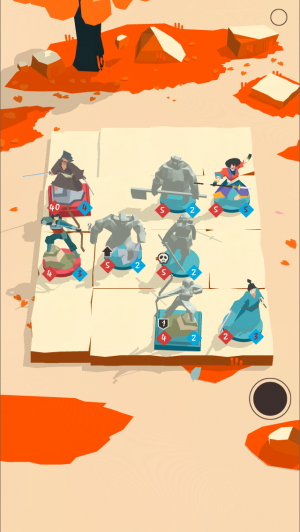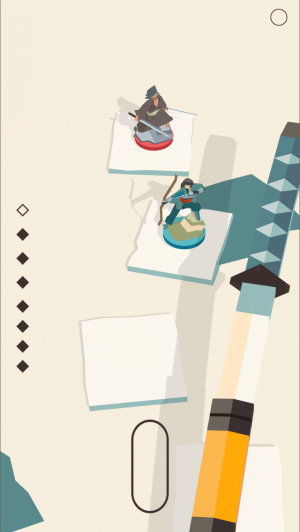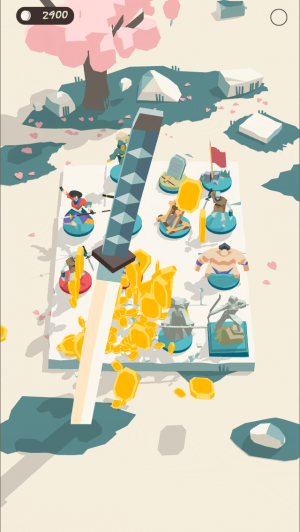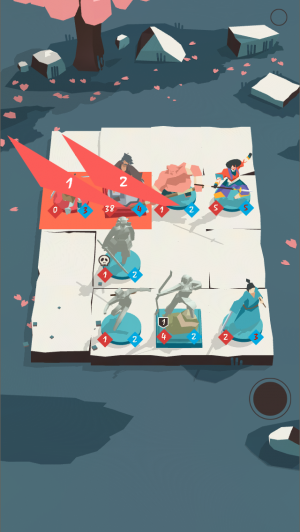Minimalism can be quite striking, but it can also make things confusing. This is somewhat the case with Miyamoto, a turn-based, roguelite strategy game with feudal Japan stylings. While it’s visuals look very clean and appealing from the outside, some confusing UI elements can make this otherwise excellent game pretty hard to play at first.

Card tactics
Miyamoto is first and foremost a skirmishing game. There’s no real story, and the only thing you do is fight a series of increasingly difficult opponents. Every fight you engage in takes place on a 4 x 4 grid. Combat takes place in a turn-based fashion, and when it’s your turn, you can move your hero and play cards around them or on enemy units to shift the tide of battle.
At the start of each fight, you have a hand of three cards, and you can play as many of them as you want. Most commonly, these cards are other units that can fight with you, but there are also structures and powerups you can play as well to modify the field of battle and those in it already. There’s no particular limit to what cards you can play beyond your limited hand size, but most units cannot be used until the turn after they’ve been played. Using these constraints, you just need to do whatever you can to protect your hero while killing the enemy hero.
Build up your forces
Miyamoto has quite a bit of card variety, so they way you can go about killing your enemies can vary considerably. You can try using a fast approach with units like ninjas and goblins that can attack on the same turn they are played, or you can opt for a more methodical approach by using ranged units or things with armor to protect everything you put in play.
You can’t exactly hand craft your deck in Miyamoto, but the game does have some ability for you to customize your army to fit your playstyle. You start with a set of cards that feels fairly standard (though it is possibly lightly randomized each time you start a new game), but you can choose to add a new card to it every time you defeat an enemy. Additionally, you earn coins each time you kill an enemy hero, which you can save up to buy new heroes that have their own unique abilities.


Underwhelming UI
The entire concept of Miyamoto is very much up my alley, and the game’s aesthetic really seals the deal for me. The game looks like a beautiful little board game that is both minimal, but also highly stylized. As great as all of the game’s art looks though, Miyamoto’s biggest sore spot is its somewhat confusing UI.
For whatever reason, Miyamoto’s icons for health and attack always confuse me. Units have a number in a red diamond on the bottom left corner of their model and another in a blue diamond on the bottom right corner of their model, which indicate a unit’s health and attack respectively. For some reason though, I find myself reversing which stat goes to which. Perhaps it’s because I’m so used to attack stats coming first from the left, followed by health, from games like Magic: The Gathering. In any case, this problem could be solved easily by having different icons for each stat. This is but one example, but there are at least half a dozen little things like this in Miyamoto that can cause confusion and have occasionally been the reason why I’ve lost a fight.
The bottom line
Miyamoto isn’t the most original idea out there, but it’s got a great look and some cool mechanics to make it worth checking out. There are some issues with the game’s presentation that make it a little less playable than I would generally like, but the action here is good enough that you might want to fight through some of those issues to play the great game hiding underneath.
PocketGamer.com
AppSpy.com
148Apps.com
PocketGamer.fr
PocketGamer.biz
PCGamesInsider.biz
The Sims News
PocketGamer.fun
BlockchainGamer.biz
PG Connects
BigIndiePitch.com
MobileGamesAwards.com
 U.GG
U.GG
 Icy Veins
Icy Veins
The Sims Resource
Fantasy Football Scout
GameKnot
Addicting Games
 Arcade Cloud
Arcade Cloud
 Wisecrack
Wisecrack
 EV.IO
EV.IO
Luminosity





